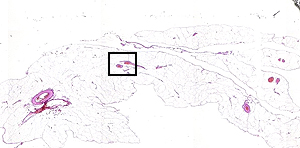|
 |
Blood vessels are of three main types: arteries, capillaries, and
veins. Arteries and veins have a 3-layered pattern to their walls.
The little box in the image to the left indicates where the picture
below came from. There are plenty of little blood vessels in this
slide so don't feel you have to stick just with ones we chose for
demonstration.
Arteries carry blood at high pressures, and therefore must have thick
walls. In all arteries, the tunica media is the thickest layer, but
its composition varies among the three general classes of artery. |